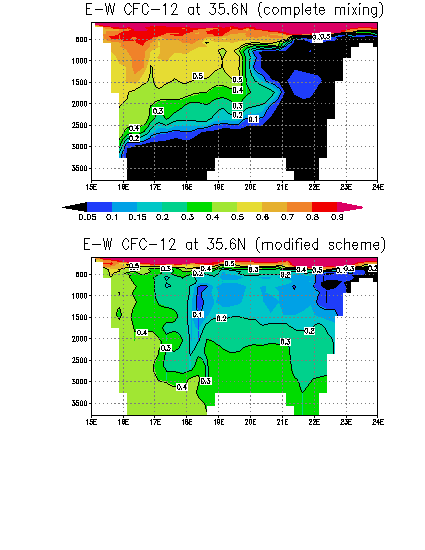ALTERNATIVE CONVECTION SCHEME
Vassil Roussenov
Oceanography Laboratories, University of Liverpool
Convection schemes are required in order to remove static instability and
to parameterise the sinking and mixing associated with convection
(see review by Marshall and Schott, 1999). The convection scheme is
particularly important for cartesian models when dense water overflows
topography and slope convection can result.
The most common convection schemes remove static instability by vertical
mixing: by increased vertical diffusivity using implicit scheme (Cox, 1984;
Marotzke, 1991), or by
direct volume weighted mixing between the neighbouring boxes (Bryan, 1969;
Cox, 1984), or mixing of
the overall unstable column (complete mixing schemes, Marotzke, 1991; Rahmstorf, 1993).
All these parameterizations lead to rapid dilution of the dense waters
during slope convection, since the mixing involves horizontal scales
much larger then the typical convection scales.
Our alternative convection scheme emphases the sinking of dense water and
reduces the excessive dilution of dense water when removing static
instability.

Figure 1:
A schematic of modified convection scheme.
When there is static instability with dense fluid at the surface overlying
a column of less dense fluid, then the scheme
(i) moves the dense fluid from the surface to the level of neutral stability
without mixing and
the overlying column of lighter fluid is displaced upwards;
(ii) the convected dense fluid is mixed with the rest of the box, and similar
volume-weighted mixing occurs within the other overlying boxes.
The scheme is conservative and removes the static instability. The
density anomaly
is reduced by the mixing within individual boxes in the scheme, but this dilution is much less than obtained in the standard schemes. An additional entrainment can
be included during the sinking, involving plume physics (Turner, 1973), which will
make the scheme similar to recently developed plume type parameterizations (Paluszkiewicz and Romea, 1997). Plume-based schemes are computationally much more expensive and we avoid adding entrainment in order to reduce explicit mixing. Note that
the convection scheme does not effect a net transport of volume, but only of properties (i.e. density or tracer concentration). In addition, the amount of property transfer and dilution in the convection scheme is a consequence of the model resolution.
Example: Eastern Mediterrabean Deep Water formation
The following diagram shows
modelled CFC-12 concentration in the Ionian Sea from
the
MOMA model. The source of dense waters is the Adriatic Sea, which is at the
top-right of Fig. 2. The model set-up and the sea-surface forcing is same
in both cases, but the convection adjustment schemes differ.

Figure 2:
CFC-12 distribution [pmol/kg] for a north-south section through the Ionian
(a) Complete mixing (standard) scheme;
(b) Modified convection scheme

Figure 3:
CFC-12 distribution [pmol/kg] for a east-west section through the Ionian
(a) Complete mixing (standard) scheme;
(b) Modified convection scheme
REFERENCES
Bryan, K., 1969. A numerical model for the study of the circulation of
the world ocean. J. Comput. Phys., 4, 347-376.
Cox, M., 1984. A primitive three-dimensional model of the ocean, Rep. 1,
Ocean Group, GFDL, Princeton, N.J.
Marotzke, J., 1991. Influence of convective adjustment on the stability of
the thermohaline circulation. J. Phys. Oceanogr., 21, 903-907.
Marshall, J. and F. Schott, 1999. Open-ocean convection: observations, theory and models. Rev. Geophysics, 37, 1, 1-64
Paluszkiewicz, T. and R.D. Romea, 1997. A one-dimensional model for the parameterization of deep convection in the ocean.
Dyn. Atmos. Oceans, 26, 95-130.
Rahmstorf, S., 1993. A fast and complete convection scheme for ocean models.
Ocean Modelling, December, 9-11.
Turner J.S., 1973. Buoyancy Effects in Fluids. Cambridge University Press. Cambridge, 367pp.
LINKS
Top of page
This page was made by V. Roussenov, University of Liverpool.
Last changed on January 20, 2000.


